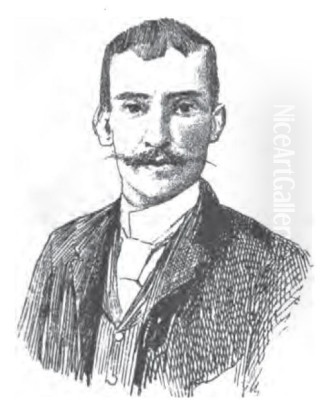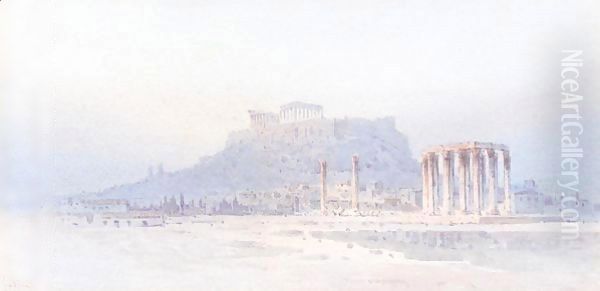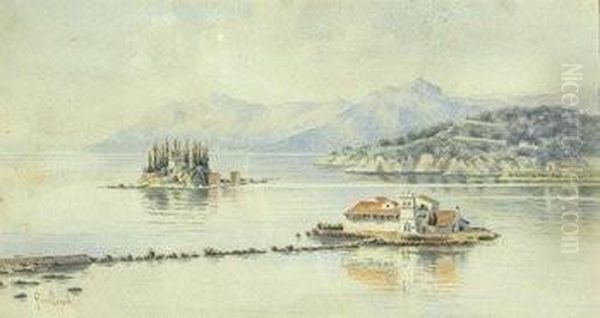
Angelos Giallina stands as a significant figure in the landscape of Modern Greek art, particularly celebrated for his mastery of the watercolour medium. Active during the late nineteenth and early twentieth centuries, Giallina dedicated his artistic vision to capturing the unique beauty and luminous atmosphere of Greece, leaving behind a prolific body of work that continues to enchant viewers today. His paintings, predominantly landscapes, serve not only as aesthetic achievements but also as poignant documents of Greek natural beauty and historical sites during a transformative period for the nation.
Early Life and Formative Years in Italy
Born in 1857 on the picturesque island of Corfu, Angelos Giallina hailed from a noble family with deep roots and connections to the Venetian-Cretan minority. This privileged background likely provided him with opportunities and exposure that nurtured his artistic inclinations from an early age. Corfu itself, with its rich history blending Greek and Venetian influences, offered a vibrant cultural environment that undoubtedly shaped his aesthetic sensibilities. The island's stunning natural scenery, characterized by olive groves, cypress trees, and a unique quality of light, would become a recurring motif throughout his career.
Seeking formal artistic training, Giallina travelled to Italy between 1875 and 1878. This period was crucial for his development. He immersed himself in the artistic hubs of Naples, Rome, and Venice. Studying in these cities exposed him to both the classical traditions and the contemporary artistic currents of Italy. The Italian landscape, its historical ruins, and the works of Italian masters likely broadened his perspective. Critically, it was during his time in Italy, particularly perhaps observing the Venetian school's facility with light and colour, that he developed a profound affinity for watercolour, a medium he would champion upon his return to Greece.
Return to Corfu and Dedication to Watercolour

In 1878, Giallina made the decisive move to return to his native Corfu and establish his permanent residence and studio there. This return marked the beginning of his mature artistic phase, characterized by an almost exclusive dedication to watercolour painting. He found in this medium the perfect vehicle for expressing the subtle nuances of the Greek landscape, particularly the soft, diffused light that bathes the Ionian Islands. Watercolour allowed for a transparency and immediacy that suited his goal of capturing fleeting atmospheric effects and the vibrant yet delicate colours of his homeland.
His studio in Corfu became a hub of creativity, from which he produced an extensive oeuvre. Giallina developed a distinctive style, marked by fluid brushwork, a keen sense of composition, and an exceptional ability to render light and shadow. He didn't just paint landscapes; he interpreted them, imbuing his scenes with a sense of tranquility and timelessness. His focus on the Corfiot countryside, its villages, coastlines, and olive groves, established him as a preeminent visual chronicler of the island. His works from this period are considered quintessential examples of his talent.
Artistic Style and Thematic Focus
Giallina's art is primarily defined by his virtuosity in watercolour. He mastered the technique, exploiting its potential for luminosity and transparency. His palette often favoured soft blues, greens, ochres, and earthy tones, reflecting the natural colours of the Greek environment. He possessed a remarkable ability to capture the interplay of light and shadow, whether depicting the bright midday sun filtering through olive leaves or the gentle glow of twilight over the Ionian Sea. His compositions are typically well-balanced, often employing traditional landscape structures but infused with a personal sensitivity.
Thematically, Giallina's work revolved around Greece. While Corfu remained a primary source of inspiration, his travels took him across the country. He painted famous archaeological sites, capturing the enduring majesty of ancient ruins set against the living landscape. Views of Athens, including the Acropolis, feature in his work, alongside scenes from other regions. Beyond Greece, his travels also led him to paint landscapes and cityscapes in Egypt, Spain, and Venice, often as part of specific commissions, showcasing his versatility and keen observational skills. Underlying all his work was a deep appreciation for nature and history, reflecting a profound connection to his Hellenic heritage.
Representative Works and Market Recognition
Several specific works exemplify Giallina's style and thematic interests, and their presence in the art market highlights his enduring appeal. Sheep in a Greek Landscape, a watercolour measuring 39 x 67 cm, showcases his ability to integrate pastoral elements into the broader landscape, capturing a sense of rural tranquility. Its estimated value between €1,000 and €1,500 reflects the accessibility of some of his works to collectors.

A more iconic subject is captured in Acropolis, measuring 28 x 43 cm. Paintings of this famous landmark allowed Giallina to engage directly with Greece's classical past. Such works often command higher prices, with this piece estimated between €8,000 and €10,000, indicating its significance and desirability among collectors of Greek art. His travels are represented by works like The Great Sphinx and Pyramid of Giza (14.5 x 30.5 cm, est. €900-€1,600) and Olympus Temple of Zeus (29 x 57.5 cm, est. £1,000-£1,500), demonstrating his skill in depicting diverse historical monuments and landscapes beyond Corfu. Another notable work, Olive Trees, Corfu, fetched between €3,000 and £4,000 at a 2024 auction, further confirming the consistent market interest in his quintessential Corfiot scenes.
Esteemed Patronage and International Exhibitions
Giallina's talent did not go unnoticed by influential figures of his time. He enjoyed significant patronage, which greatly contributed to his success and reputation. A key relationship was with the British Ambassador, Sir Clare Ford. Ford became a major supporter, commissioning Giallina to create seven albums of watercolours depicting scenes from Greece, Spain, and Venice. These albums served not only as artistic achievements but also as valuable cultural documents, likely circulated among elite circles.
His clientele extended to European royalty and aristocracy, including members of the British, Austrian, and German royal families. A notable commission involved contributing to the decoration of the Achilleion Palace in Corfu, built for Empress Elisabeth (Sisi) of Austria. This association with high-profile patrons underscored his status as a leading artist. Giallina's work was also showcased in numerous exhibitions, both in Greece (Athens) and internationally, including London, Paris, Berlin, and various cities in Spain. These exhibitions broadened his exposure and solidified his reputation beyond Greek borders.
Place within Modern Greek Art
Angelos Giallina occupies an important position within the history of Modern Greek art, particularly bridging the 19th and 20th centuries. While often associated with the broader movement of Greek artists seeking to define a national artistic identity following independence, his style remained largely rooted in a form of realistic landscape painting, enhanced by his watercolour technique, rather than engaging deeply with the modernist experiments that characterized later movements. His work predates, yet perhaps anticipates in its focus on Greek light and landscape, some concerns of the influential "Generation of the '30s" artists like Yiannis Tsarouchis or Nikos Hadjikyriakos-Ghikas, though his style is distinct.
He can be seen in the context of other prominent Greek artists of the late 19th century, such as the masters of the "Munich School," Nikiforos Lytras and Nikolaos Gyzis, who focused more on genre scenes and portraiture, often with a heavier, oil-based technique learned in Germany. Giallina's dedication to watercolour and landscape set him apart. Compared to the maritime focus of Konstantinos Volanakis, Giallina offered a broader perspective on the Greek terrain. His work also relates to the tradition of the Ionian School of painting, which flourished in Corfu and surrounding islands, represented by earlier figures like Nikolaos Koutouzis and Nikolaos Kantounis, known for portraiture and religious themes but sharing a connection to the region's unique cultural blend. Giallina effectively translated the Ionian artistic spirit into the realm of landscape watercolour.
Influence and Lasting Legacy
Angelos Giallina's influence during his lifetime was significant, particularly in popularizing watercolour as a serious medium for depicting Greek subjects. His beautiful and numerous works inspired contemporaries and likely encouraged other artists to explore the potential of watercolour for capturing the specific atmospheric conditions of Greece. His success with international patrons also helped to promote Greek art abroad.
Today, Giallina's legacy is preserved through his extensive body of work, which remains highly sought after by collectors. His paintings are held in major public and private collections, including the National Gallery of Greece in Athens, the Athens Municipal Gallery, and importantly, the Corfu Municipal Gallery, which holds a significant collection reflecting his deep connection to the island. His depictions of Corfu, Athens, and other Greek locales continue to be admired for their technical skill, aesthetic beauty, and evocative portrayal of a Greece bathed in idyllic light. He remains one of the most beloved Greek landscape painters of his era.
Artistic Connections and Context
While the available records don't detail specific collaborations or direct rivalries between Giallina and other painters, his career unfolded within a rich artistic milieu. His Italian training placed him in dialogue with the legacy of European academic art. His chosen medium, watercolour, connects him to a broader European tradition, mastered by artists like Britain's J.M.W. Turner, whose atmospheric effects, though often more dramatic, share a preoccupation with light, and John Singer Sargent, who also produced stunning watercolour landscapes during his travels.
Within Greece, he worked concurrently with figures like Georgios Jakobides, known for his tender depictions of childhood. While their subject matter differed, they were part of the same generation shaping Greek art. Later artists who continued to explore Greek landscape and light, such as Spyros Papaloukas and Konstantinos Parthenis (a key figure moving towards modernism), inherited a tradition to which Giallina had significantly contributed, even if their styles evolved differently. His depictions of Egypt also place him in the context of European artists travelling East, like the Scottish painter David Roberts, famous for his detailed views of Near Eastern monuments. Even portraitists patronized by the same royal circles, such as Franz Xaver Winterhalter, form part of the wider artistic network Giallina navigated. Though direct interactions may be undocumented, Giallina's work clearly resonates within these national and international artistic contexts.
Conclusion: Capturing the Soul of Greece in Watercolour
Angelos Giallina remains a cherished figure in Greek art history, celebrated as a preeminent master of watercolour. His life, rooted in the unique culture of Corfu and enriched by his Italian education, led to an artistic career dedicated to capturing the essence of the Hellenic landscape. Through his prolific output, characterized by luminous light, delicate colour, and tranquil compositions, he offered an enduring vision of Greece's natural beauty and historical resonance. His work found favour with prominent patrons and reached international audiences, solidifying his reputation. Today, his watercolours continue to be admired in museums and collections, serving as timeless testaments to his skill and his deep connection to the land and light of Greece.